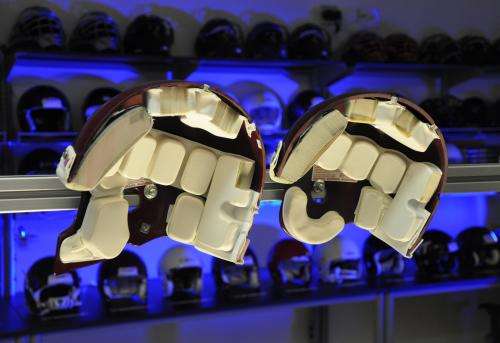New study finds differences in concussion risk between football helmets

Football helmets can be designed to reduce the risk of concussions, according to a new study by some of the nation's leading concussion researchers published today in the Journal of Neurosurgery.
The study analyzed head impact data compiled from eight collegiate football teams that included Virginia Tech, University of North Carolina, University of Oklahoma, Dartmouth College, Brown University, University of Minnesota, Indiana University, and University of Illinois. Six years of data were collected between 2005 and 2010. During this time a total of 1833 players wore helmets that were equipped with sensors to measure the biomechanics of over one million head impacts. All players either wore a Riddell VSR4 or Riddell Revolution helmet. The researchers compared the rates of concussion between the two helmet types.
The manuscript reports a 54 percent reduction in concussion risk for players in the Riddell Revolution compared to players in the VSR4 helmet. "This is the first study to control for the number of times players hit their heads when comparing helmet types," said Steve Rowson, lead author and an assistant professor in the Virginia Tech – Wake Forest School of Biomedical Engineering and Sciences. "No previous study has been able to account for this variable. Controlling for head impacts allows you to compare apples to apples. For example, you're not comparing a player in one helmet who rarely gets hit to a player in another helmet type who frequently gets hit."
The sensors in the helmets measured head acceleration for each impact players experienced. Players in the VSR4 helmets experienced higher head accelerations resulting from impact than players in Revolution helmets. The authors attribute this to the Revolution helmets better modulating the energy transfer from the impact to the head, which results in lower head accelerations. "Helmets that better lower head acceleration reduce concussion risk," Rowson said.
The authors stress that no helmet will ever be able to prevent all concussions. "While some helmets will reduce risk more than others, no helmet can eliminate risk," said Stefan Duma, professor and head of the Virginia Tech – Wake Forest School of Biomedical Engineering and Sciences. Better helmet design is just one of many strategies that play a role in reducing concussions in football. "The most effective strategies are altering league rules and teaching players better techniques. These strategies focus on reducing the number of head impacts that players experience," Duma added. "However, head impacts in football will always occur, even with the best rules and technique. This is where improving helmet design to best reduce concussion risk becomes critical. Our data clearly demonstrate that this is possible."

















